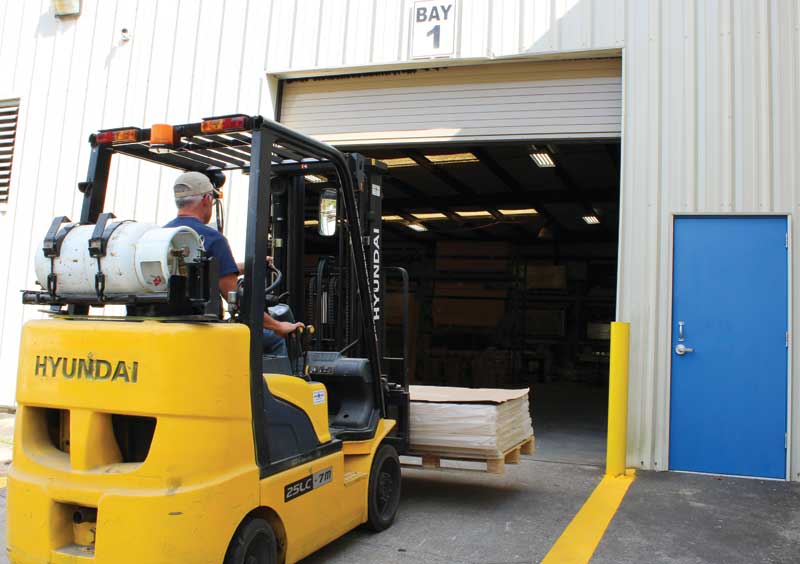
When specifying a high-performance door, it is best to look at the entire construction of the closure to ensure all components of the door are durable, in addition to speed and other performance attributes. Chances are, the door will either fail to meet or drastically exceed the client’s needs, and so the ‘Goldilocks’ approach is best here: if the application requires an opening that operates at 610 mm (24 in.) per second, a door that operates at 508 mm (20 in.) per second will be too slow, a door that operates at 813 mm (32 in.) per second will be overkill, and a door that operates at 610 mm per second will be just right.
Defining the desired door opening speed in inches per second will eliminate any doors that are not quite the right fit for the application. Door opening speed is determined by considering factors such as total opening height, frequency of opening, and additional factors such as:
- number of parking stalls or fork trucks going through the opening;
- traffic patterns;
- equal flow of traffic throughout the day compared to rush hour traffic (with opening speed increasing for heavily used openings); and
- placement of activation devices to signal the door to open (e.g. placing activation devices further away reduces need for high opening speed).
It is also a good idea to look into springless models, as they minimize maintenance and eliminate the need to replace springs over time.
Performance
Peak cycle times are much more important than lifetime cycles when it comes to high-performance rolling doors. Defining peak cycle times and ensuring the door can handle the client’s specific needs is the number-one priority. For example, instead of specifying a 200,000 cycle door, it is more helpful to state the peak period of cycling is 75 cycles per hour from 7 to 9 a.m. and 4 to 6 p.m. to ensure the door is able to handle the peak times appropriately.
Maintenance
Maintenance concerns may not always be at the forefront of an architect’s mind, but they are crucial for a building owner or facility manager. Effective high-performance doors require virtually no maintenance outside of daily checks. No maintenance means no downtime, which is a huge operational benefit. While initial cost may be higher, the benefit of eliminating maintenance costs and resulting downtime compared to a standard rolling door makes it worthwhile to many owners.
A major contributor to the low maintenance requirements of high-performance doors is a springless design. Springs wear over time and have to be replaced to avoid failure. This is a major issue with high-cycle doors, as premature wear and failure can lead to spring snapping—and an inoperable door. A springless design is therefore desired and preferred for demanding settings.
Associated costs
There are very real, tangible costs to specifying and installing the wrong door, which can more than double the cost of a less expensive option. For starters, productivity can drop significantly. A standard service door can open at about 203 mm (8 in.) per second. This can feel like an eternity to someone driving a forklift truck and waiting for it to open. Pausing, even for as little as 20 seconds, can end up costing hours and days of productivity in a 24/7 operation that uses the door for every pass-through.
For example, when a door is out of service or closed for repairs, employees may need to spend extra time to drive forklifts out of their way to use an operational door. This means more products must go through fewer openings. If each employee takes an extra four minutes, multiplied by the 50 people working in the factory, this equals 200 minutes, or 3.3 hours per day. If this is a 365-day operation, the yearly impact is 3.3 x 365, or 1204.5 hours per year. If the average salary is $20 per hour, this translates into a very real cost of $24,090 in lost productivity, annually.
Not only can maintenance delays on doors force employees to reroute to a different door that is further away, but when a standard rolling door is run more often than is recommended, it can also overheat the motor, wear out components, or even snap springs, rendering the door unusable. In contrast, high-performance rolling doors open at speeds of up to 610 mm (24 in.) per second, and are constructed to withstand heavy continuous use.
If the client’s facility requires a regulated temperature and a standard rolling door is specified, money will also be lost each time it slowly cycles. The typical opening speed of a standard door is enough time for blustery winter winds to enter a facility, or hot summer temperatures to counteract the air-conditioning. This can impact energy costs for the entire lifetime of the door.




